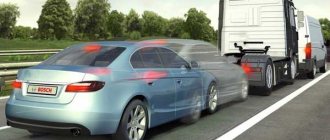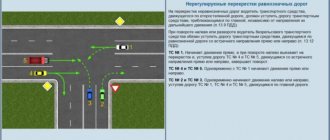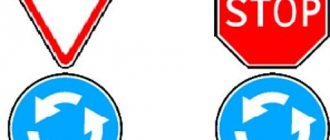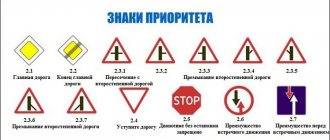To be precise, the Rules of the Road do not describe this rule with precisely these words “Interference on the right”. This requirement in itself is very clear - the driver needs to give way to vehicles approaching the intersection from the right side.
Dear readers! Our articles talk about typical ways to resolve legal issues, but each case is unique. If you want to find out how to solve your particular problem, please use the online consultant form on the right or call ext. 647. It's fast and free!
This rule is applied in cases where there are no other controls for the order of passage of the intersection :
- no advantage indications,
- traffic lights are missing or not working,
- no traffic controller
- the roads themselves are equivalent, and the routes of vehicles may intersect.
Question 1: What is “interference from the right”?
Let’s make a reservation right away: the traffic rules do not contain such terms as “right-hand rule” and “right-hand interference.” These are conditionally simplified expressions of clause 8.9 of the Russian Traffic Regulations. Its essence is as follows. Rules cannot cover all traffic priority situations. Therefore, if the sequence of passage of vehicles is not provided for by traffic regulations, then drivers must pass each other, allowing “interference on the right” to pass. Only after this can you continue moving.
In other words, if we cross the path of another car along the route, and the order of movement is not specified by the Rules, then we will have to give way to this car if it is on our right at the moment of crossing.
In this case, the truck driver must pass the intersection first, since for a passenger car it is on the right
Accordingly, our opponent should be guided by the same rule: if we interfere with him on the right, then he must provide us with the right of first passage.
Thus, if the priority of movement cannot be determined by signs, a traffic controller or a traffic light, then our “obstacle on the right” should receive priority from us in movement.
Crossroads
The concept of “interference on the right” is a way to simplify the understanding and practical application of the provisions of 13.11 of the Traffic Rules. Literally, this concept can be used only in 1 case - when entering an intersection formed by equivalent roads.
This intersection has the following features:
- The presence (but not mandatory) of sign 1.6 about the intersection of roads with equal priority.
- Absence of other priority signs.
- Lack of traffic lights and traffic controllers.
- If the traffic light is faulty, or if it only gives 1 flashing yellow signal.
In this case, the car on the right has the right to be the first to make any maneuver permitted by the rules, except for a turn. When turning, the car becomes an obstacle on the left and loses priority.
Example: a car turning right has priority over a car that entered the intersection from the opposite direction and intends to turn in the same direction.
Conditions for applying the right hand rule or right hand interference
The principle we are interested in is considered to be rightfully universal. However, it is necessary to clearly know the boundaries of its application, because the “right hand” rule (like any other norm) has mandatory criteria (conditions). There are three of them.
The trajectories of vehicles must certainly intersect.
Interference on the right and crossing paths
Otherwise, why solve problems of advantage in motion? After all, the cars will not be able to interfere with each other in any way and will calmly move away in the given directions.
In this case, “interference from the right” does not work, since the trajectories do not intersect
This rule applies to equal traffic participants.
In other words, none of the participants in the “conflict of interest”, who always strive to pass first, should have some kind of status advantage. On the contrary, he must be equal to his opponents.
For example, the “interference from the right” principle (or the “right hand” rule) cannot be applied in the following relationship systems:
1) pedestrian – vehicle;
2) a tram is a trackless vehicle.
Both the tram and the pedestrian are traffic participants with a special legal status.
The order of passage of vehicles should not be specified by traffic rules.
In other words, the case when we plan to apply this very rule should not be provided for by the traffic rules.
Let's take a specific example: we are leaving a parking lot together with another car. A situation not covered by traffic regulations. In this case, we give way to him, because for us now he is an obstacle on the right.
Leaving the parking lot and there is an obstacle on the right. The oncoming person has no interference on the right, and neither do we. But that's it for now. But when we start moving, we will have an obstacle on the right, but he won’t. Therefore, we give in.
And here is another case - the simultaneous restructuring of equivalent subjects. The first to change lanes is the motorcycle, which has no obstacle in the form of a “passenger car” on the right. But the driver of a passenger car, on the contrary, is forced to recognize the obstacle to the right of the motorcyclist. Therefore, it is he who is obliged to give the motorcyclist an advantage.
When changing lanes at the same time, the driver of a passenger car must yield, since the motorcyclist is an “obstacle on the right” for him. However, if a passenger car were moving straight, then it would have an advantage, since it moves without changing direction and the motorcyclist must let it pass
Movement while changing lanes at the same time
The “Interference on the right” rule in the acceleration lane “does not work.”
When changing lanes, the vehicle that does not change lanes has priority. But when changing lanes at the same time, the advantage is on the side of the vehicle moving on the left and changing lanes to the right lane. There is some dissonance with the requirements that prescribe giving way to the one on the right. In fact, this requirement is caused by security issues. The driver of a car that occupies the right lane is, as a rule, able to more accurately assess the situation on the road, and by trying to leave the “line of fire,” he can save his neighbor on the right by his behavior. And also about the interference on the right when changing lanes. We are talking about acceleration lanes made so that the car can pick up speed sufficient to not interfere with traffic moving along the highway. And if, in a hurry to exit onto the highway, you “catch” another car, you will be found to be the culprit of the accident - the “interference on the right” rule in the acceleration lane “does not work”, just like when entering a city street from a courtyard area. As a conclusion, blind obedience to traffic rules can sometimes lead to completely unnecessary accidents on the road . Let's say you're driving along a main road covered in the first snowfall. And from the secondary lane a car flies towards the intersection, and judging by its desperate attempts to slow down, the car is still on summer tires. It doesn’t cost anything to just slow down your car, which is already “studded,” and let the person complete the maneuver. Honestly, in gratitude he will flash his emergency lights until the next intersection.
Question 2: When does “interference from the right” not work?
Now let's consider the conditions when “interference from the right” does not work. In principle, this issue has already been discussed in the previous section, “Conditions for applying the right-hand rule.” But there it was decided from a positive standpoint: when does this rule apply? Now we are interested in the negative.
Inconsistency between the statuses of traffic participants.
The principle of “interference from the right” does not work if the participants in the movement are initially unequal in status. We have already noted the most common combinations of participants:
- pedestrian and vehicle;
- "rail" tram and trackless transport.
The right hand rule cannot be applied here.
Inequality of priority positions of traffic participants.
The “right hand” rule will not work for participants who are in positions of different priority (prescribed by signs, traffic lights or traffic controllers).
In this case, the “right hand” rule does not work
Let's take the first example. Judging by the picture, drivers are in different priority positions: one on the main road, the other on the secondary road. Therefore, they cannot apply the “right hand” rule among themselves, because the one on the main road will always pass first. It’s just that at the moment he already has an advantage and is obliged to take advantage of it.
In this case, the driver of a car must give way
Let's take the second example. One participant follows the road, the second leaves the gas station (or yard). Their “conflict” cannot be resolved using the “interference on the right” principle, because, according to traffic rules, those leaving the adjacent territory are obliged to give way to everyone.
In this case, the bus must pass first, despite the fact that it has an obstacle on the right
Let's be puzzled by the third case. One participant moves under the main green traffic light, and the second to an additional section of the traffic light, but to the main red one (or any other prohibiting one). Initially, their positions are unequal, because a person moving into an additional section when the main traffic light is prohibiting must first let through all those who are leaving for the main permissive traffic light.
An interesting case with the order of travel and the incorrect interpretation of the “right hand” rule occurred in May 2020 in Naberezhnye Chelny. Drivers S. Ivanov and N. Morozov were moving in the same direction and making a turn from Chulman Avenue to Yashlek Avenue. Both cars were driving parallel and the turn was made through a gap in the median. S. Ivanov’s car was to the left of N. Morozov’s car. In the process of leaving the avenue, a collision occurred and, according to the traffic police inspector, Ivanov was the culprit, since he did not allow the car on the right, moving in the same direction, to pass, as a result of which Ivanov was fined 500 rubles. Unfortunately for the traffic cop, citizen Ivanov turned out to be a persistent comrade and appealed the inspector’s decision in the city and republican courts, which sided with the inspector. Ultimately, it reached the Supreme Court, which sided with the driver and overturned the decisions of the lower courts. The Supreme Court explained its decision by the fact that when turning left, N. Ivanov took the extreme left position on the roadway in advance and therefore the “interference on the right” rule is not applicable in these circumstances.
There are other cases when this rule does not apply (for example, when starting to move or reversing, you must first give way to other road users).
“Interference on the right” when driving through intersections
Although this will not be entirely correct, the “right hand” rule has practical significance - it can be used when driving through intersections. And although the traffic rules (section 13) quite clearly regulate the rules for driving through intersections, they can still be significantly simplified by applying this most universal “right hand” rule.
This principle can be formulated as follows: with absolutely equal opportunities, we drive away from other vehicles, applying the “right hand” rule.
The difficulty in applying this rule at an intersection is due to the dynamic nature of events. Let's take the example in the figure. Currently, no driver is impeded on the right. But then we started moving, entering an intersection.
Making a left turn, the motorcyclist receives interference from us on the right. He stops and lets us pass.
At the moment the oncoming motorcyclist begins to turn, we find ourselves as “interference on the right.” This means that our opponent must let us through and only then proceed in the direction he needs.
However, when driving through an intersection, it is important to remember the cases when the “right hand” rule cannot be applied. These are cases of clear regulation of the order of movement.
"Conflict" with the tram.
The tram must pass first, it has priority, just because it is a tram
The "right hand" rule does not apply to trams. In their “pure” form, they have priority over us.
Initial inequality of positions.
If traffic participants are initially located in directions of different priorities (some on the main, some on the secondary), then their relations will not be resolved using the “interference from the right” principle.











